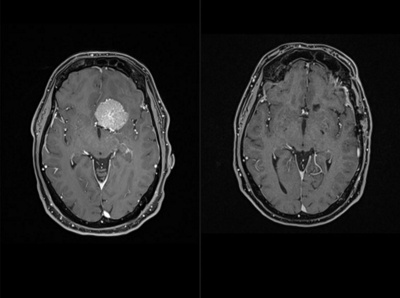Brain tumours are masses that grow inside the skull, in nerve tissue or the lining of the brain (meninges).

Types of brain tumours
Brain tumours are divided into three categories, depending on which tissue they are growing in: meningiomas, neuromas and gliomas. In contrast to tumours in other organs, there is no black and white distinction between malignant and benign brain tumours. Even benign tumours that do not form metastases can cause life-threatening damage to the brain.
Gliomas
Gliomas are a type of malignant tumour that are found in the brain’s supportive tissue (Glia cells). Gliomas are categorised as either astrocytomas, oligodendrogliomas, glioblastomas or mixed gliomas. They affect people of all ages. Glioblastomas are the most common type of malignant brain tumour in adults.
Meningiomas
Meningiomas develop in the lining of the brain (meninges). There are malignant and less malignant varieties. Meningiomas are virtually only found in adults. They most commonly affect people between the ages of 40 and 60.
Neuromas
Neuromas grow in the cells that surround the nerve fibres. They occur most frequently on the auditory nerves in the inside of the skull, which is why such tumours are called acoustic neuromas. Neuromas are usually benign, but like all brain tumours, their growth can damage the surrounding nerve tissue.
Metastases
Brain metastases, referred to in medical terms as cerebral metastases, occur when tumours from other body regions affect the brain, i.e these cells establish themselves in the brain. Brain metastases differ to brain tumours in that they do not consist of brain tissue. Tissue samples are taken to determine the type of tissue that the cells originally stemmed from.
Causes
The causes of the different kinds of brain tumours are largely unknown. It has not yet been proven whether electromagnetic radiation plays a role in the development of tumours.
Symptoms
Brain tumour symptoms can vary widely, depending on where the tumour is located.
An acoustic neuroma primarily causes problems with hearing and balance. However, the symptoms caused by other tumours are less specific.
Headaches, dizziness or nausea could indicate a brain tumour, although such symptoms are much more likely to be caused by something harmless. Sudden inexplicable health problems or ongoing symptoms should always be checked by a doctor.
Sometimes brain tumours can cause vision problems, distorted speech, signs of paralysis, loss of feeling, muscle weakness or seizures.
Diagnosis of brain tumours
Various different medical examinations are used to diagnose brain tumours. They include comprehensive neurological examinations, as well as computed tomography (CT) and magnetic resonance imaging (MRI). Occasionally a lumbar puncture is carried out to investigate the brain fluid, or an electroencephalogram is used to measure the brain’s electrical waves.
Surgical treatment
The treatment is determined according to the source of the tumour and its location. Whenever possible, an attempt is made to surgically remove the tumour. Surgical treatment can be successful in the case of benign tumours like neuromas or some meningiomas. Brain operations are carried out using special, modern neurological procedures like laser surgery and radiosurgery, as well as technologies such as surgical robots.
Radiotherapy and chemotherapy
If the tumour is malignant, or if surgery is not possible due to the location of the tumour, the treatment options include Radiotherapy or Chemotherapy. The objective of radiotherapy is to change the atoms and molecules in the cancer cells, which should cause the cells to die off. During chemotherapy, inroads are made into the metabolism of the cancer cells. In the process, the growth of the cells is inhibited and the cancer is killed off.



